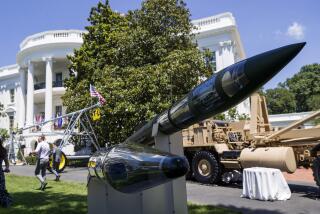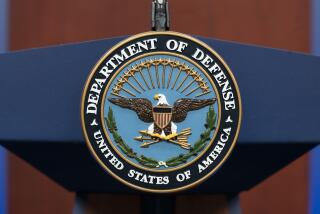U.S. boosts its military presence in Persian Gulf
- Share via
Reporting from Washington — The Pentagon quietly shifted combat troops and warships to the Middle East after the top American commander in the region warned that he needed additional forces to deal with Iran and other potential threats, U.S. officials said.
Marine Corps Gen. James N. Mattis, who heads U.S. Central Command, won White House approval for the deployments late last year after talks with the government in Baghdad broke down over keeping U.S. troops in Iraq, but the extent of the Pentagon moves is only now becoming clear.
Officials said Thursday that the deployments are not meant to suggest a buildup to war, but rather are intended as a quick-reaction and contingency force in case a military crisis erupts in the standoff with Tehran over its suspected nuclear weapons program.
The Pentagon has stationed nearly 15,000 troops in Kuwait, including a small contingent already there. The new deployments include two Army infantry brigades and a helicopter unit, a substantial increase in combat power after nearly a decade in which Kuwait chiefly served as a staging area for supplies and personnel heading to Iraq.
The Pentagon also has decided to keep two aircraft carriers and their strike groups in the region.
This week, the American aircraft carrier Carl Vinson joined the aircraft carrier John C. Stennis in the Arabian Sea, giving commanders major naval and air assets in case Iran carries out its recent threats to close the Strait of Hormuz, a strategic choke point in the Persian Gulf through which one-fifth of the world’s oil shipments passes.
“There’s enough going on in that part of the world that you can see the merit in having a robust presence,” said a senior Pentagon official, speaking on condition of anonymity about military movements.
Navy officials say Iran might be able to temporarily block tanker traffic through the strait using antiship missiles and other weapons, but U.S. commanders say they can reopen the waterway quickly if necessary.
Gen. Ataollah Salehi, head of Iran’s army, warned the John C. Stennis not to return to the Persian Gulf after the aircraft carrier passed through the strait this month. The ship is scheduled to return to the U.S. soon, but officials said it will be replaced by the Enterprise in order to keep two carriers in the volatile region.
U.S. officials are divided over how much to publicize the deployments. Regional allies tend to dislike public discussion about their cooperation with Washington. But the Pentagon wants Iran’s rulers to know that the U.S. still has adequate forces available in the event of a crisis.
They include the Army’s 1st Cavalry Division’s 1st Brigade, which shifted to Kuwait from Iraq when the last U.S. forces left last month. The brigade, which has more than 4,500 soldiers and is equipped with tanks and artillery, has been designated a “mobile response force” for the region, according to Col. Scott L. Efflandt, the brigade commander.
A National Guard brigade from Minnesota has been in Kuwait since August, and a combat aviation brigade arrived in December. Another major unit is heading to Kuwait shortly, though officials would not provide details.
Despite the buildup in Kuwait, the total number of U.S. troops in the region has declined with the withdrawal of all U.S. forces from Iraq and the drawdown of U.S. troops that began last summer in Afghanistan.
Also Thursday, the Obama administration imposed sanctions on three companies that sell gasoline to Iran. Although Tehran is the world’s third-largest exporter of oil, it has limited refining capacity and must import most of its gasoline.
The State Department said it would bar U.S. export licenses and most U.S. financing for the Zhuhai Zhenrong Co., which is based in China and is the largest seller of gasoline to Iran. Also sanctioned was Kuo Oil Pte. Ltd., an energy trading firm based in Singapore, and FAL Oil Co., an independent energy trader based in the United Arab Emirates.
Times staff writer Paul Richter contributed to this report.
More to Read
Sign up for Essential California
The most important California stories and recommendations in your inbox every morning.
You may occasionally receive promotional content from the Los Angeles Times.











